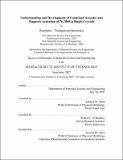Understanding and development of combined acoustic and magnetic actuation of Ni₂MnGa single crystals
Author(s)
Techapiesancharoenkij, Ratchatee, 1979-
DownloadFull printable version (2.913Mb)
Other Contributors
Massachusetts Institute of Technology. Dept. of Materials Science and Engineering.
Advisor
Samuel M. Allen and Robert C. O'Handley.
Terms of use
Metadata
Show full item recordAbstract
Ni-Mn-Ga based ferromagnetic shape memory alloys (FSMAs) have emerged as a promising new class of active materials capable of producing a large (several %) magnetic-field-induced strain (MFIS). FSMAs still have several characteristic shortcomings that may limit their potential applications. A threshold field of 2 to 4 kOe must be overcome to initiate twin boundary motion and a larger field is required to achieve full actuation. The operating window of the stress output from FSMA actuators is narrow and limited to the range between 0.5 and 2 MPa. Outside the operating range, the strain output diminishes significantly. This thesis addresses these limitations and reports potential techniques to decrease the required threshold field and increase the stress and strain output of FSMA actuation. The demagnetizing field due to magnetic poles on the surface of the sample is found to significantly influence the maximum field needed for full MFIS. The demagnetizing field decreases the effective internal field inside the FSMA sample; as a result, for a given external field, the magnetic driving force is reduced by the demagnetizing field. For a small demagnetization factor, full MFIS can be achieved at a field as low as 0.5 kOe. However, for a high demagnetization factor, full MFIS may require a field as high as 3.5 kOe. A phenomenological free energy model with an approximate magnetostatic term included properly describes this. The application of an acoustic assist from a 33-mode piezoelectric stack is shown to improve MFIS of Ni-Mn-Ga single crystals by reducing the required threshold field and twinning-yield stress. Threshold field reductions of up to 1 kOe are observed, and the twinning-yield stress is reduced by up to 0.5 MPa. The piezo assist on FSMA actuation can be understood as a form of time varying stress waves that facilitate twin boundary motion. (cont.)The stress-wave theory and FEM analyses, based on assumption of an elastic and isotropic material, are used to estimate the amplitude of stress waves. The stress values determined from the wave theory and FEM are comparable to the observed reduction in twinning-yield stress (0.6 to 2 MPa). The empirical stress wave amplitude is generally lower than the calculated one, because the actual stress waves generated in FSMA are limited by inelastic and anisotropic nature of the FSMA samples. For FSMA samples with twin planes oriented 45o to the elongation axis, longitudinal stress waves parallel to the elongation axis are the most effective type to facilitate twin boundary motion. Longitudinal stress waves impart uniaxial tensile/compressive stresses into the sample normal to its base, resulting in the maximum shear stresses along the 45o twin planes. On the contrary, the transverse stress waves are the least effective type, because the resulting shear stresses along the twin planes are equal to zero. This is confirmed by the comparison of the effectiveness of the piezo-assist using the longitudinal 33-mode and transverse 15-mode piezo stacks. The maximum reduction of twinning-yield stress of 0.5 MPa is observed with the longitudinal piezo assist, while a maximum twinning stress reduction of only 0.05 MPa can be achieved by the transverse piezo assist. For FSMA cyclic actuation, both operating stress and strain outputs of the FSMA actuation are significantly enhanced by the piezo-assisted effect. Without the piezoassistance, the maximum reversible strain of the sample used here is 3% and appears only in the limited external stress range between 0.7 and 1 MPa. With the piezo-assistance, the maximum reversible strain increases to 4.5% and appears in a broader range of stress output between 0.4 and 1.2 MPa. (cont.)The reduction in the twinning-yield stress due to the acoustic-assistance obviously improves the FSMA cyclic actuation performance; any magnetic energy not used to drive twin boundary motion can potentially be utilized to work against a larger external stress. The magnetic stresses for a given magnetic field, calculated from the free energy model, appear to be larger than the empirical ones. The demagnetization effect is shown to be responsible for much of the deviation. The demagnetization effect reduces the internal field needed to move twin boundary and do external work.
Description
Thesis (Ph. D.)--Massachusetts Institute of Technology, Dept. of Materials Science and Engineering, 2007. This electronic version was submitted by the student author. The certified thesis is available in the Institute Archives and Special Collections. Includes bibliographical references (p. 143-148).
Date issued
2007Department
Massachusetts Institute of Technology. Department of Materials Science and EngineeringPublisher
Massachusetts Institute of Technology
Keywords
Materials Science and Engineering.